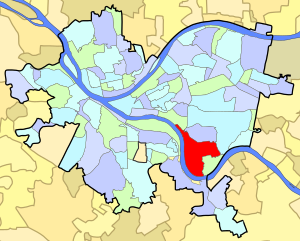Hazelwood (Pittsburgh)
Hazelwood | |
|---|---|
 The John Woods House, built in 1792, is perhaps the oldest house in the city of Pittsburgh. | |
 | |
| Coordinates: 40°24′32″N 79°56′28″W / 40.409°N 79.941°W | |
| Country | United States |
| State | Pennsylvania |
| County | Allegheny County |
| City | Pittsburgh |
| Area | |
| • Total | 1.583 sq mi (4.10 km2) |
| Population (2010)[1] | |
| • Total | 4,317 |
| • Density | 2,700/sq mi (1,100/km2) |
Hazelwood is a neighborhood of Pittsburgh, Pennsylvania in the United States. It is represented on Pittsburgh City Council by Corey O'Connor. It is bordered by Greenfield and Oakland on the north, Squirrel Hill and Glen Hazel on the east, and the Monongahela River on the south and west. The Pittsburgh Bureau of Fire houses 13 Engine and 13 Truck in Hazelwood.
Early history
In 1758 a large tract of woodland was purchased for $10,000 under the Stanwix Treaty made with the Native-Americans. This area would include Hazelwood and Greenfield of the 15th ward.
Hazelwood takes its name from the hazelnut trees which once flourished along the Monongahela river. The first settlers were of Scottish descent and settled what was known as Scotch Bottom. This area ran from Four Mile Run (lower Greenfield) to Six Mile Ferry, four and six miles (10 km) from the Point (where the Allegheny and Monongahela Rivers merge) respectively. Among the first settlers was John Woods, a politician who built his 'Hazel Hill' estate in 1784. That house still stands, the second oldest stone building in Pittsburgh after The Fort Pitt Blockhouse. Eventually, large farms were cut out of the wooded hills, attracting more residents and supplying the area with further wealth.
Industrial age

The first track of railroad was built by Mr. B. F. Jones, of the Pittsburgh and Connellsville Railroad and later of Jones and Laughlin. Unlike most lines, this railroad was built inland as to respect the residents concern of maintaining the river's aesthetic value. This railroad would later separate Hazelwood into two sections, coining the local term 'below the tracks'. In 1869 Hazelwood was incorporated into the city, and by the following year the railway had spurred iron and steel industries, railroading, boatbuilding and the river trade.
By the late 19th century Hazelwood was a bustling town. In the 1950s the neighborhood was host to over 200 businesses. It had become home to large Hungarian, Italian, Slovak, Carpatho-Rusin, Polish, and Irish populations. With the construction of the Civic Arena in the Hill District large African-American populations made Hazelwood a home.
In the 1980s the steel industry began to decline. As the industry packed up, so did business and many residents. Like many areas in the rust-belt, Hazelwood fell into disrepair. Hazelwood was home to the city of Pittsburgh's last operating steel mill, the Hazelwood Coke Works, which was owned by Jones and Laughlin and later, its parent company, LTV, when it closed in 1998.[2]
Recently, Hazelwood has been working to improve as a community. Many abandoned buildings have been razed, and new ones constructed in their place. In addition, some parks, such as Lewis Playground, in the neighborhood have been updated to provide recreation for the residents.
Hazelwood and Glen Hazel are family-oriented neighborhoods, with many community activities focusing on youth programs. The neighborhoods are noted for their numerous churches and the active roles they play in building community spirit and pride in their residents.[citation needed]
According to a December 23, 2008, article in the Pittsburgh Post-Gazette, Dimperio's Market, the only full service grocery store in Hazelwood, would close because of shoplifters.[3]
Modern development
| External audio | |
|---|---|
The ALMONO Partnership, a non-profit organization led by the Regional Industrial Development Corporation (RIDC), is planning to re-develop 178 acres of riverfront property on the former Hazelwood Coke Works site, which is currently vacant brownfield land.[5] In May 2013, the City of Pittsburgh Planning Commission approved the re-zoning of the former industrial land into zoning appropriate for ALMONO's planned uses, which include roughly 2 million square feet of office space, 1,300 housing units, and a light-industrial technology park, as well as riverfront recreation facilities. Recently, ALMONO and RIDC have completed site grading, a major first step in the development.[5][6][7] If completed in its entirety, the project is anticipated to cost US$900 million.[7][8]
Notable residents
- Playwright August Wilson lived in Hazelwood as a teenager
- Professional Baseball Player (AAGPBL) Marguerite Pearson
- Rapper Wiz Khalifa
- Rapper Chevy Woods
See also
References
- ^ a b "PGHSNAP 2010 Raw Census Data by Neighborhood". Pittsburgh Department of City Planning. 2012. Retrieved 24 June 2013.
- ^ McNulty, Timothy (January 4, 2009). "Hazelwood hopes to reshape its community despite blows". Pittsburgh Post-Gazette.
- ^ Thieves cause Hazelwood grocery to give up, Pittsburgh Post-Gazette, December 23, 2008
- ^ "Hazelwood, A Pittsburgh Neighborhood on the Cusp of Change". Grapple. Keystone Crossroads. Retrieved November 17, 2016.
- ^ a b Almono Partnership Development Map.
- ^ http://www.hatchmott.com/projects/almono-riverfront-development
- ^ a b Belko, Mark (28 May 2013). "Planners approve zoning for massive Hazelwood project at LTV site". Pittsburgh Post-Gazette. Retrieved 24 June 2013.
- ^ O'Toole, Christine (January 22, 2013), "Pittsburgh's Three Rivers, Now a Public Attraction", New York Times, New York
Further reading
- Toker, Franklin (1994) [1986]. Pittsburgh: An Urban Portrait. Pittsburgh: University of Pittsburgh Press. ISBN 0-8229-5434-6.
- Hazelwood: History
- "The plume is gone. But we can't forget Hazelwood". Pittsburgh Post-Gazette.
